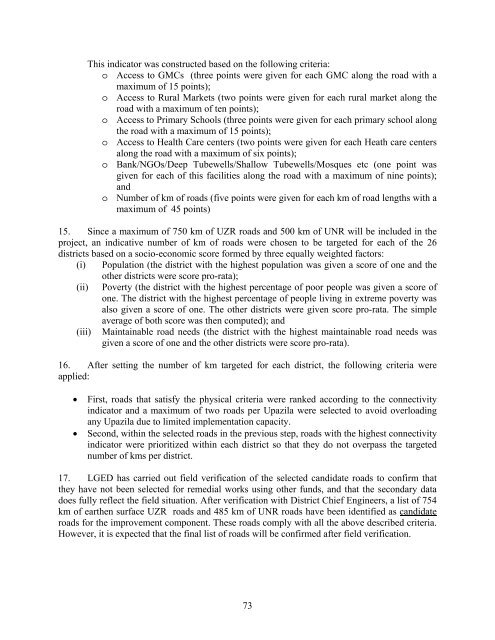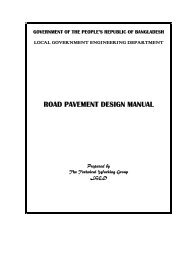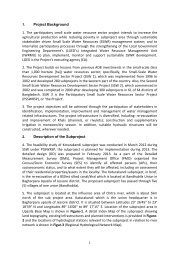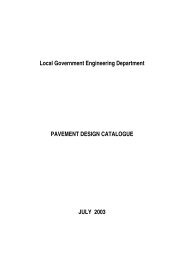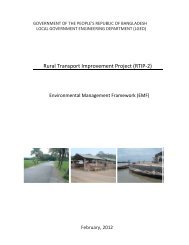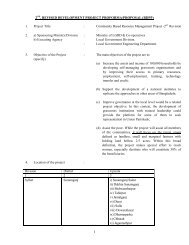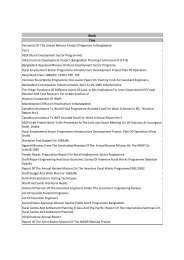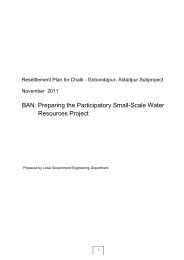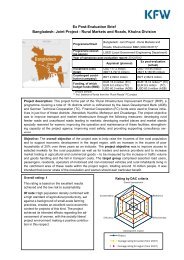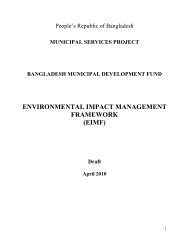PAD - LGED
PAD - LGED
PAD - LGED
Create successful ePaper yourself
Turn your PDF publications into a flip-book with our unique Google optimized e-Paper software.
This indicator was constructed based on the following criteria:<br />
o Access to GMCs (three points were given for each GMC along the road with a<br />
maximum of 15 points);<br />
o Access to Rural Markets (two points were given for each rural market along the<br />
road with a maximum of ten points);<br />
o Access to Primary Schools (three points were given for each primary school along<br />
the road with a maximum of 15 points);<br />
o Access to Health Care centers (two points were given for each Heath care centers<br />
along the road with a maximum of six points);<br />
o Bank/NGOs/Deep Tubewells/Shallow Tubewells/Mosques etc (one point was<br />
given for each of this facilities along the road with a maximum of nine points);<br />
and<br />
o Number of km of roads (five points were given for each km of road lengths with a<br />
maximum of 45 points)<br />
15. Since a maximum of 750 km of UZR roads and 500 km of UNR will be included in the<br />
project, an indicative number of km of roads were chosen to be targeted for each of the 26<br />
districts based on a socio-economic score formed by three equally weighted factors:<br />
(i) Population (the district with the highest population was given a score of one and the<br />
other districts were score pro-rata);<br />
(ii) Poverty (the district with the highest percentage of poor people was given a score of<br />
one. The district with the highest percentage of people living in extreme poverty was<br />
also given a score of one. The other districts were given score pro-rata. The simple<br />
average of both score was then computed); and<br />
(iii) Maintainable road needs (the district with the highest maintainable road needs was<br />
given a score of one and the other districts were score pro-rata).<br />
16. After setting the number of km targeted for each district, the following criteria were<br />
applied:<br />
• First, roads that satisfy the physical criteria were ranked according to the connectivity<br />
indicator and a maximum of two roads per Upazila were selected to avoid overloading<br />
any Upazila due to limited implementation capacity.<br />
• Second, within the selected roads in the previous step, roads with the highest connectivity<br />
indicator were prioritized within each district so that they do not overpass the targeted<br />
number of kms per district.<br />
17. <strong>LGED</strong> has carried out field verification of the selected candidate roads to confirm that<br />
they have not been selected for remedial works using other funds, and that the secondary data<br />
does fully reflect the field situation. After verification with District Chief Engineers, a list of 754<br />
km of earthen surface UZR roads and 485 km of UNR roads have been identified as candidate<br />
roads for the improvement component. These roads comply with all the above described criteria.<br />
However, it is expected that the final list of roads will be confirmed after field verification.<br />
73


